Even if you are new, you would have known about this extremely common exercise performed by bodybuilders and average trainers.
However, the world ‘deadlift’ can seem extremely daunting.
You will understand that ‘deadlifting’ is one of the must do exercises to get you closer to looking in great shape. The deadlift can benefit all types of fitness levels, but also be damaging if performed wrong.
Deadlifting is one of few exercises that work all major muscle groups in the body. Depending on the variation and stance it can work your:
- Lower back.
- Hamstrings
- Glutes
- Calves
- Quads
- Upper back
- Traps
- Spinal erectors
- Hips
- Glutes
- Hamstrings
Why not stop and find a different approach. Stop conventional deadlifting and try different variations. Multiple variations will push your deadlift PB in the right direction.
Put these variations into your training plan and feel stronger, faster, more powerful but most of all muscle gains.
It’s up to you to decide which deadlift is your type and most suited to your goals, strengths and weaknesses.
Types And Variations Of The Deadlift
Jefferson Deadlift

The Jefferson deadlift – also known simply as the Jefferson lift – is a classic strongman movement. The Jefferson deadlift is great for strength, power, core stability, and hip durability. It should be a staple in any serious strength athlete’s routine.
The movement is a great way to encourage people to get their knees open so they can take a wider stance in their squats while building some rotational range of motion. It also coaxes them outside of a pure saggital plane movement pattern that can become dominant if not addressed.
The cool thing about a Jefferson deadlift is everyone will have a slightly different way of approaching it. The basics are as follows:
- Straddle the bar
- Grab the bar
- Stand up with the bar
More specifically:
- Make sure your spine remains relatively linear so you aren’t rounding or seriously deviating away from a neutral position.
- When you start pulling, make sure your knees don’t collapse towards the midline in a valgus party you sure don’t want to be invited to.
- Don’t lock out your knees before your hips get through the movement; otherwise you’ll be doing a really awkward good morning with nothing but your hips.
- Take a grip that’s vertical under your shoulders and not wider.
Sumo Deadlift

- Begin with a bar loaded on the ground.
- The feet should be set very wide, near the collars. Bend at the hips to grip the bar.
- The arms should be directly below the shoulders, inside the legs, and you can use a pronated grip, a mixed grip, or hook grip.
- Lower your hips, looking forward with your head and your chest up.
- Drive through the floor, spreading your feet apart, with your weight on the back half of your feet.
- Extend through the hips and knees.
- As the bar passes through the knees, lean back and drive the hips into the bar, pulling your shoulder blades together.
- Return the weight to the ground by bending at the hips and controlling the weight on the way down.
The sumo deadlift will place emphasis on the quads and provides a range of motion which allows you to lift heavier.
Hex or Trap Bar Deadlifts

- For this exercise load a trap bar, also known as a hex bar, to an appropriate weight resting on the ground.
- Stand in the enter of the apparatus and grasp both handles.
- Lower your hips, look forward with your head and keep your chest up.
- Begin the movement by driving through the heels and extend your hips and knees.
- At the completion of the movement, lower the weight back to the ground under control.
By using the hex bar you can change the mechanics behind the deadlift and lift evenly distributing your weight.
Snatch Grip Deadlift
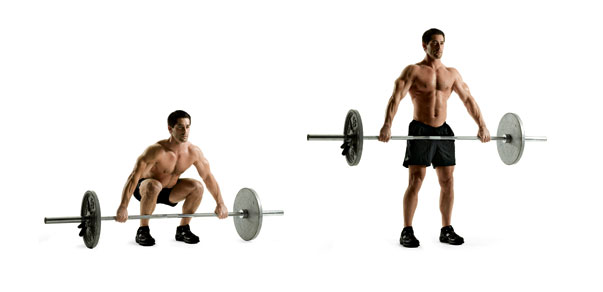
- The snatch deadlift strengthens the first pull of the snatch. Begin with a wide snatch grip with the barbell placed on the platform.
- The feet should be directly under the hips, with the feet turned out.
- Squat down to the bar, keeping the back in absolute extension with the head facing forward.
- Initiate the movement by driving through the heels, raising the hips.
- Drive your hips through the bar as you lay back.
- Return the bar to the platform by reversing the motion.
The snatch deadlift mainly works the hamstrings. In the snatch grip deadlift your hands take on a wider grip.
Romanian Deadlift, Stiff Legged Deadlift, Straight Leg Deadlift

- Hold a bar at hip level with a pronated (palms facing down) grip. Your shoulders should be back, your back arched, and your knees slightly bent.
- Lower the bar by moving your butt back as far as you can. Keep the bar close to your body, your head looking forward, and your shoulders back.
- At the bottom of your range of motion, return the starting position by driving the hips forward to stand up tall.
The Romanian deadlift- sometimes called the straight legged dead lift focuses on using the hamstrings.
Deficit Deadlift / Rack Pulls
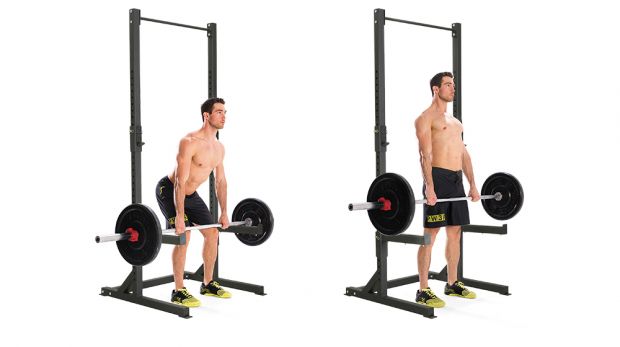
- Set up in a power rack with the bar on the pins. The pins should be set just below the knees, just above, or in the mid thigh position.
- Position yourself against the bar in proper deadlifting position.
- Your feet should be under your hips, your grip shoulder width, back arched, and hips back to engage the hamstrings.
- Since the weight is typically heavy, you may use a mixed grip, a hook grip, or use straps to aid in holding the weight.
- With your head looking forward, extend through the hips and knees, pulling the weight up and back until lockout.
- Return the weight to the pins and repeat.
The deficit deadlift can use a conventional and snatch grip width.
The Hack Lift
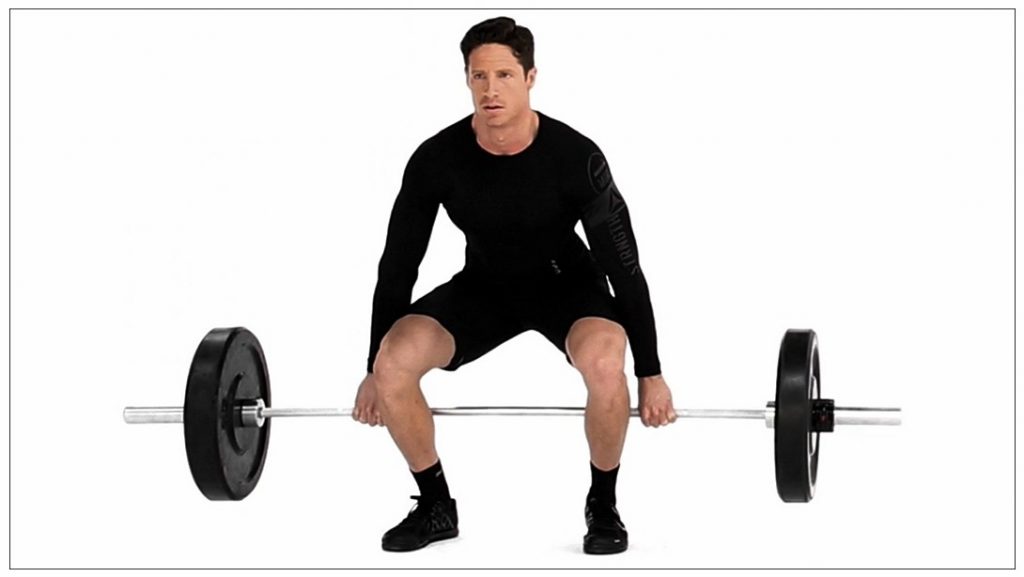
- Stand up straight while holding a barbell behind you at arms length and your feet at shoulder width.
- While keeping your head and eyes up and back straight, squat until your upper thighs are parallel to the floor.
- Pressing mainly with the heel of the foot and squeezing the thighs.
- Repeat for the recommended amount of repetitions.
Variations: This exercise can also be performed with your heels slightly elevated on a small block.
The hack lift is a deadlift that focuses on the quadriceps.
Conventional Deadlift

- Approach the bar so that it is centred over your feet. Your feet should be about hip-width apart.
- Bend at the hip to grip the bar at shoulder-width allowing your shoulder blades to protract.
- With your feet and your grip set, take a big breath and then lower your hips and flex the knees until your shins contact the bar. Look forward with your head.
- Keep your chest up and your back arched, and begin driving through the heels to move the weight upward.
- After the bar passes the knees aggressively pull the bar back, pulling your shoulder blades together as you drive your hips forward into the bar.
- Lower the bar by bending at the hips and guiding it to the floor.
Conventional deadlifts target and work the lower back, calves, forearms, glutes, hamstrings, lats, middle back, quads and traps.
Form, Execution And Mistakes
- All weight should be focused on your heels and the middle of your foot.
- Your body should move upwards and down wards at the same speed.
- Keep your chest upright and drive with your heels.
- Keep your arms straight. They should not be used to bend or pull at anytime.
- Keep the bar close to your body.
- As you pull, squeeze your glutes. Once the bar passes your knees, push through the floor with your feet, once you reach the knees pushing and squeeze your glutes under the bar.
- At the top of the movement, stand tall with your chest open.
- Performing the deadlift can be simple once you’ve mastered the correct stance and form.
- Because of the nature of the bio mechanics and range of motion, deadlifts should be done with caution.
- To avoid injury and mistakes you need to make sure you have the correct deadlifting form. Practice both with and without a bar.
- Try not to drop the bar, put the bar down and practice lowering the bar with correct motion, movement and form.

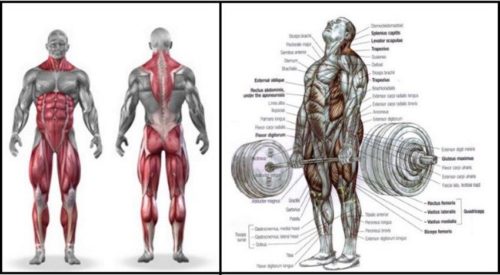
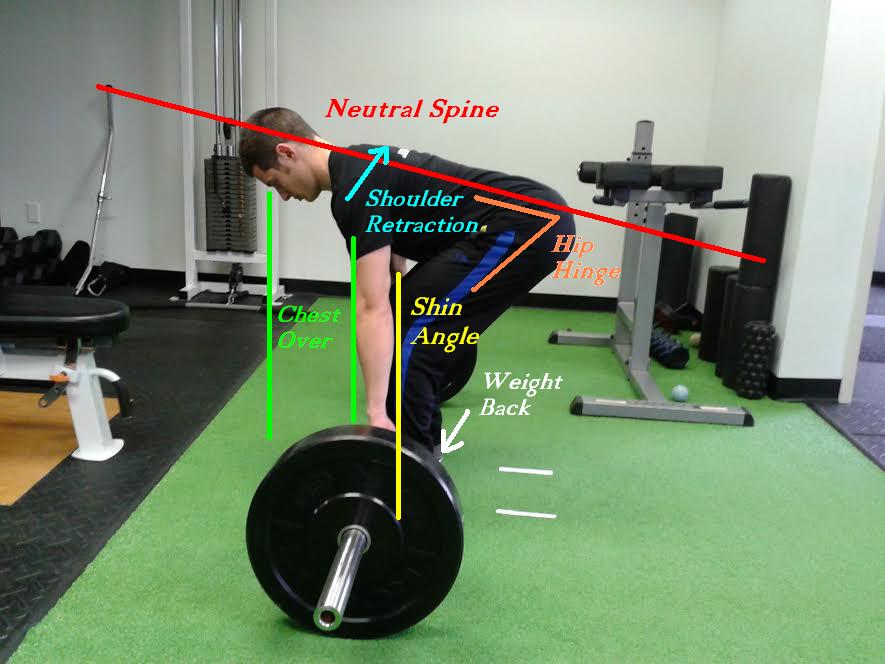

Post your comment